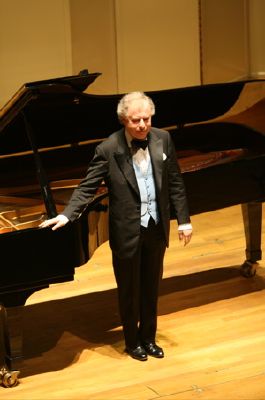|
<<< << -- 2 -- Malcolm Miller 'BACH THE EUROPEAN'

András Schiff's lecture recital followed, with wonderfully expressive, exciting and beautifully ornamented accounts of Bach's French Suite No 5, Italian Concerto and English Suite No 6 in D minor. In each work the contrapuntal and dance-like textures came alive with fine shading, and detailed articulation that radiated a thorough immersion in Bach's style and purpose. He prefaced the programme with a touching account of the F minor Sinfonia a 3, which he said was one of his favourite works, an essay which, with its searching dissonances, contained a whole world of experience in just a few minutes. In his informal, relaxed and stimulating spoken commentary to the works, Schiff explained that while Bach was clearly 'European', he travelled far less than contemporaries such as Scarlatti and Handel, remaining within Germany and only journeying for musical reasons, such as his trip to Hamburg and Munster to hear Buxtehude. However, he was a 'learned' composer, absorbing contemporary European styles by copying and transcribing the works of others. Schiff traced the derivation of the separate dances of each of the Suites he played, underlining the cosmopolitan array in each: the French Suite contained an Italian Courrente, whilst the English suite featured a French Courante; each had an English-derived Gigue. The Sarabande expressed a distinctive intersection of sacred and secular in Bach's music, injecting a mood of spirituality to a secular work just as dance movements added vitality to sacred works like the St Matthew Passion.

András Schiff. Photo © 2007 Mark Whitehouse
|
Schiff's performances were, as expected, masterly, especially energetic and lively in the fast movements, delicately tripping and poetically introspective in the Sarabandes. If, for Schiff, Bach's style in the French Suite suggested some of the qualities of a painting by Vermeer, transparent and detailed, the D minor English Suite was on a more majestic scale, more like a Rembrandt. In its final movement, Schiff drew an interesting comparison of the Gigue with Beethoven's Waldstein sonata, in which a trill was combined with leaping arpeggios, while in the Gigue's second part he etched out the B-A-C-H motif stridently. It was a performance of grandeur and eloquence. In the central work, the Italian Concerto abounded with Concerto Grosso style contrasts of textures and dynamics. Originally conceived for a two manual keyboard, Schiff in characteristically sparkling manner remarked 'you may ask why I play it on a single-manual instrument: well, I don't know!' He described the Italianate ornamentation of the slow movement, comparing it with variations 13 and 25 of the Goldberg, and also pointed out how the static accompaniment suggested an orchestral colouring, for instance two viola da gambas. With a rather faster-than-usual tempo, his interpretation stressed the aria's linear continuity, leading to the exciting bristling finale which pulsated with electricity. As an encore, Schiff performed the very first of the Two Part Inventions, yet with a florid triplet decoration of the main motif, which made it sound fresh and supple. Received with a much deserved enthusiastic ovation, it formed a beguiling conclusion to an inspiring lecture-recital and a memorable event.
Copyright © 10 October 2007
Malcolm Miller, London UK

|

